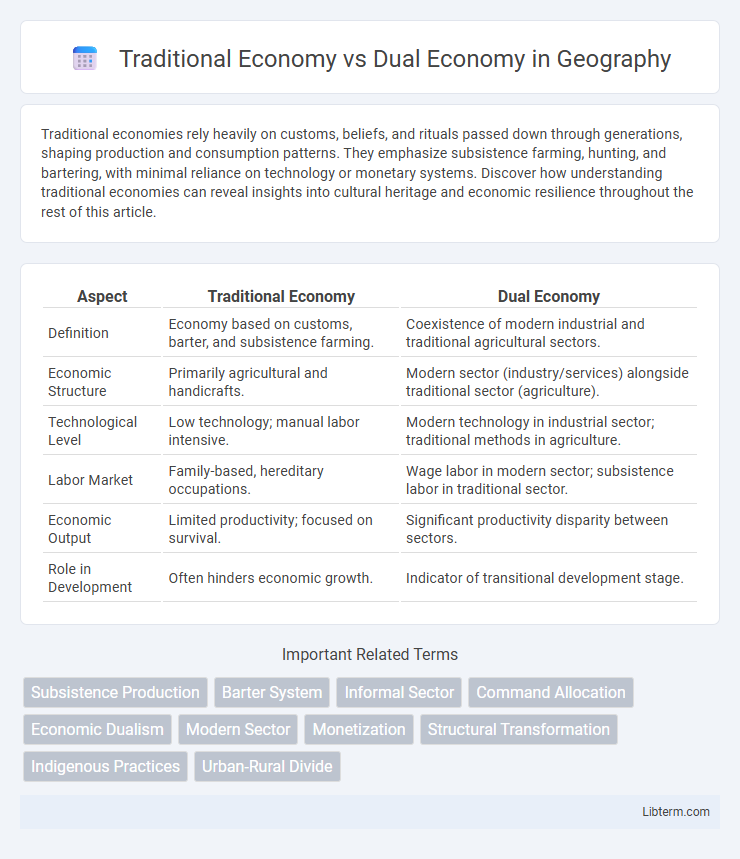Traditional economies rely heavily on customs, beliefs, and rituals passed down through generations, shaping production and consumption patterns. They emphasize subsistence farming, hunting, and bartering, with minimal reliance on technology or monetary systems. Discover how understanding traditional economies can reveal insights into cultural heritage and economic resilience throughout the rest of this article.
Table of Comparison
| Aspect | Traditional Economy | Dual Economy |
|---|---|---|
| Definition | Economy based on customs, barter, and subsistence farming. | Coexistence of modern industrial and traditional agricultural sectors. |
| Economic Structure | Primarily agricultural and handicrafts. | Modern sector (industry/services) alongside traditional sector (agriculture). |
| Technological Level | Low technology; manual labor intensive. | Modern technology in industrial sector; traditional methods in agriculture. |
| Labor Market | Family-based, hereditary occupations. | Wage labor in modern sector; subsistence labor in traditional sector. |
| Economic Output | Limited productivity; focused on survival. | Significant productivity disparity between sectors. |
| Role in Development | Often hinders economic growth. | Indicator of transitional development stage. |
Defining Traditional and Dual Economies
A traditional economy is characterized by subsistence agriculture, barter trade, and reliance on customs and rituals, typically observed in rural and undeveloped regions. A dual economy consists of two interconnected sectors: a modern industrial sector and a traditional agricultural sector, highlighting disparities in productivity, income, and technology between the two. This model explains economic development challenges in countries transitioning from subsistence farming to industrialization.
Historical Contexts of Traditional and Dual Economies
Traditional economies have historically dominated pre-industrial societies, relying heavily on subsistence agriculture, barter systems, and community-based resource allocation. Dual economies emerged during colonial and post-colonial periods, characterized by the coexistence of a subsistence sector and a modern, capitalist sector within the same country, often reflecting stark inequalities. This economic framework highlights the transition from traditional practices to industrialization, illuminating structural divides rooted in historical contexts of development and external influences.
Core Characteristics of Traditional Economies
Traditional economies rely heavily on customs, rituals, and subsistence agriculture, with production methods passed down through generations and minimal technological innovation. These economies typically feature barter systems, limited market exchange, and communal ownership of resources, emphasizing social cohesion over individual profit. Labor specialization is minimal, and economic roles are often determined by age, gender, or family lineage within tight-knit communities.
Fundamental Features of Dual Economies
Dual economies exhibit a distinct structural division between a modern, capitalist sector and a traditional, subsistence sector, often characterized by vastly different levels of productivity and technological adoption. The coexistence of these sectors results in labor market segmentation, with surplus labor in the traditional sector maintaining low wages in the modern sector, thereby affecting income distribution and economic growth. Key features include capital accumulation in the modern sector, underemployment in rural areas, and persistent disparities in income, productivity, and resource allocation.
Key Differences Between Traditional and Dual Economies
Traditional economies rely heavily on subsistence agriculture, barter trade, and stable customs rooted in long-standing cultural practices, while dual economies feature a coexistence of a modern industrial sector alongside a traditional agricultural sector. In dual economies, income disparity is prominent due to the significant productivity gap between the two sectors, contrasting with traditional economies where wealth distribution is more homogeneous but limited by low economic growth. Key differences also include the role of technology and market integration, with dual economies exhibiting higher technological adoption and external market participation compared to the closed, self-sufficient nature of traditional economies.
Advantages of Traditional Economy Systems
Traditional economy systems offer stability by relying on established customs and practices that have sustained communities for generations. These economies promote sustainability through resource conservation and minimal environmental impact, as production is closely aligned with local needs. Moreover, social cohesion and strong community bonds are maintained, fostering cooperation and mutual support among members.
Challenges Facing Dual Economies
Dual economies face significant challenges including structural disparities where a modern industrial sector coexists with a traditional agricultural sector, leading to uneven income distribution and productivity gaps. Limited access to capital and technology in the traditional sector restricts growth and perpetuates poverty. Policy formulation is complex due to conflicting interests between sectors, hindering cohesive economic development and integration.
Economic Growth and Development Implications
Traditional economies often experience constrained economic growth due to reliance on subsistence agriculture and limited technological innovation, which restricts productivity and capital accumulation. In contrast, dual economies exhibit structural disparities where a modern industrial sector coexists with a traditional agricultural sector, creating uneven development and income distribution challenges that impact overall economic progress. Understanding these dynamics is crucial for formulating policies aimed at integrating sectors, promoting investment, and accelerating sustainable economic development.
Case Studies: Countries with Traditional and Dual Economies
Countries like Nepal and Chad exemplify traditional economies, relying heavily on subsistence agriculture, bartering, and limited technological advancement. In contrast, India and Nigeria exhibit dual economies characterized by the coexistence of modern industrial sectors alongside traditional agricultural practices. These case studies highlight how dual economies face challenges in balancing modernization with preserving traditional economic activities, affecting growth and development trajectories.
Future Prospects and Policy Recommendations
Future prospects of traditional economies revolve around sustainable development through integrating modern technology with indigenous knowledge, preserving cultural heritage while improving productivity. Dual economies require targeted policy recommendations emphasizing structural transformation, inclusive growth by bridging the divide between the subsistence agricultural sector and the modern industrial sector. Strategic investment in education, infrastructure, and innovation fosters balanced development and enhances the resilience of both economic segments in emerging markets.
Traditional Economy Infographic

 libterm.com
libterm.com